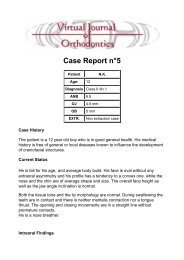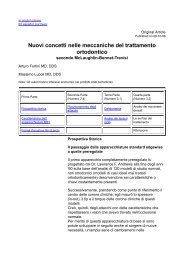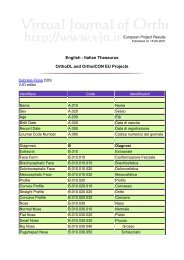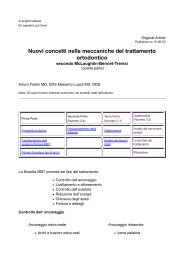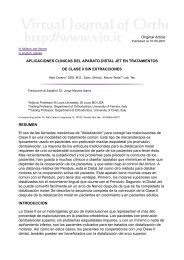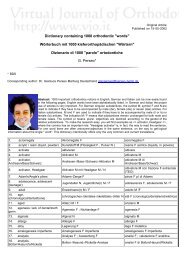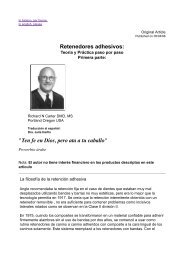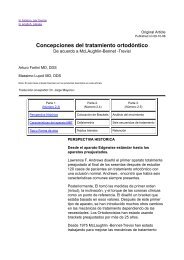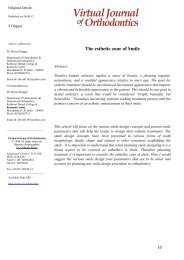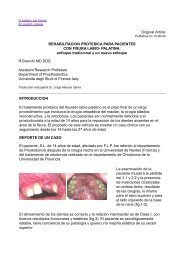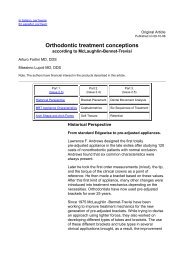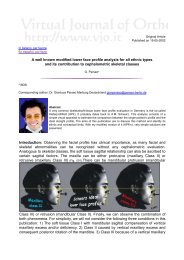Download Document (929.04 Kb) - Virtual Journal of Orthodontics
Download Document (929.04 Kb) - Virtual Journal of Orthodontics
Download Document (929.04 Kb) - Virtual Journal of Orthodontics
You also want an ePaper? Increase the reach of your titles
YUMPU automatically turns print PDFs into web optimized ePapers that Google loves.
In italiano, per favore<br />
Re-Published Article*<br />
Published on 20/10/97<br />
Ac.C.O Modified appliance<br />
Sergio Colli, MD DDS<br />
Giambattista Carnevale Miacca, MD<br />
Celso Minghini Dent. Techn.<br />
*This article appeared in the 52 nd "Bollettino di Informazioni Ortodontiche".<br />
Reprinted and translated by the permission <strong>of</strong> authors and the editor Leone S.p.A.<br />
Copyright © 1997 All rights reserved.<br />
Of the many distalizing appliances, the ACCO (ACrylic Cervical<br />
Occipital) has been shown to be successful among orthodontists.<br />
This is partly due to its effectiveness whenused in conjunction with<br />
extra-oral traction. (Fig. 1 )<br />
Fig. 1- The Original Ac.C.O<br />
This removable appliance, introduced in Italy by Dr. Cetlin, is<br />
equipped with two finger springs located mesial to the first molars.<br />
These springs deliver a very small distal force (30-40 gr. according<br />
to Cetlin).(Fig. 2)<br />
Extra-oral traction (150-200 gr.) shouldbe worn for 10-12 hours per day.<br />
The purpose <strong>of</strong> extra-oral traction is to control tipping<strong>of</strong> the molars.<br />
The most appreciable advantage <strong>of</strong> this appliance is that using low forces, it allows for bodily movement<br />
<strong>of</strong> molars (single force+ couple force) with complete occlusal clearance (due to the anterior bite plane).<br />
The distalization achieved is therefore more stable and less prone to relapse.<br />
However, in clinical use, some drawbacks may occur causing<br />
treatment delay. The most common difficulty is related to the<br />
insertion <strong>of</strong> the finger spring into the space betweenthe molar and<br />
the tooth mesial to it, sincethis contact is <strong>of</strong>ten tight, preventing full<br />
seating <strong>of</strong> the appliance (Fig. 3). To solve this problem, it is usually<br />
necessary to separate the teethprior to insertion.
Another difficulty concerns the necessity for periodic activation <strong>of</strong><br />
the springs so that the force levels are continuous. The continuous<br />
force delivered is one <strong>of</strong> the advantages <strong>of</strong> this appliance.<br />
The modified Ac.C.O.<br />
In order to eliminatethe separation appointment, wehave<br />
developed a modified plate exploiting the characteristics <strong>of</strong> the<br />
elasticity <strong>of</strong> the nickel-titanium alloys. Leaving the acrylic part <strong>of</strong> the<br />
plate unchanged, the distalizing components have been altered<br />
(Fig. 4). At the distal<strong>of</strong> the plate close to the molars, we<br />
incorporated two sections <strong>of</strong> .019 x .025 "Thermal-memory"<br />
rectangular wire (Leone). As for the distalizing force, we applied an<br />
open "Memory" coil spring (Leone heavy type .014) inserted into<br />
the acrylic from the side to prevent it fromescaping.<br />
These nickel-titanium springs can deliver a constant force <strong>of</strong> 50 gr.<br />
in a progressive manner and are therefore very elastic. (Fig. 5)<br />
A .022" x 0.028" sheath is soldered on the lingual <strong>of</strong> each molar<br />
band. The sheaths can then accept the coilspring<br />
assembly.Tipping control is achieved using the wire guides<br />
inserted in the sheath and from their natural reactivation when<br />
distorted, from the temperature <strong>of</strong> the oral cavity. (Fig. 6)<br />
As with the original Ac.C.O., this appliance is stabilized by two<br />
Adams clasps on the first bicuspids and also undercuts at the<br />
upper central and lateral incisors. For this reason Dr. Cetlin<br />
recommends re-adapting the acrylic periodically (Fig.7)<br />
Clinical cases:<br />
To evaluate the clinical effectiveness <strong>of</strong> this appliance we will demonstrate a case. An 11 year old female<br />
patient presented with dental and skeletal Class II division I malocclusion and skeletal dolico-facial<br />
characteristics. (Fig. 8) To evaluate whether the distalization achieved was bodily or not, weused only the<br />
Ac.C.O. plate without the use <strong>of</strong> extra-oral traction.
Cefalometric Analysis<br />
method Ricketts<br />
age:11 years<br />
Normal Value<br />
Clinical<br />
Value<br />
Description<br />
1 - Basion-Nasion and CC-Gnathion (degree) 90 +3/-3 87 Facial angle<br />
2 - Fh plane and CF-XI (degree) 76 +3/-3 76 mandibular position<br />
3 - Fh plane and facial plane (degree) 87,7 +3/-3 85.5 facial depth<br />
4 - Ans-XI and Xl-Pm (degree) 47 +4/-4 43 anterior facial height<br />
5 - Fh plane and Nasion-A (degree) 90 +3/-3 91 maxillary depht<br />
6 - inter-incisor angle (degree) 130 +8/-8 122<br />
7 - piano Fh e Nasion-Basion (degree) 27 +2/-2 29.5 cranic deflection<br />
8 - DC-XI e Xl-Pm (degree) 27 +4/-4 25 mandibular arch<br />
9 - A-Pogonionfrom 11 - (mm.) 1 +2/-2 1.4 protrusion <strong>of</strong> inf. incisor<br />
10 - A-Pogonionand 11- (degree) 22 +4/-4 22 inclination <strong>of</strong> inf. incisor<br />
11 - A-Pogonionfrom 11 + (mm.) 3.5 +2/-2 7.8 protrusion <strong>of</strong> sup. incisor<br />
12 - A-Pogonionand 11+ (degree) 26 +4/-4 36.5 inclination <strong>of</strong> sup. incisor<br />
13 - Gonion-Gnathion and facial plane (degree) 68 +3.5/-3.5 67.5 .<br />
14 - PTV from +6+ (age 11) (mm.) 14 +2/-2 13 molar position<br />
15- inferior lip protrusion (mm.) -2.4 +2/-2 1.4<br />
16- superior lip protrusion (mm.) -2.9 +2/-2 -0.3<br />
17 - A from flacial plane (mm.) 1.3 +2/-2 5.3 convexity<br />
18 - Fh plane and Gonion-Gnathion (degree) 25.3 +4/-4 27 F.M.A.<br />
19 - Fh plane and Pns-Ans (degree) 1 +1/-1 -1.5 inclination <strong>of</strong> palatal plane<br />
20- Overjet (mm.) 2.5 +1.5/-1.5 6.3<br />
21- Overbite (mm.) 2.5 +1.5/-1.5 3.1<br />
22 - +1 + respect to CC-Gn (degree) -1
23 - goniac angle (degree) 120.5 +3/-3 140<br />
SKELETAL DEFINITION<br />
Dolico Meso<br />
Brachi<br />
1. Facial axis angle ***.***.*** 87<br />
3. Facial depht ***.***. 85.5<br />
4. Facial inferior heigth 43 **.**.**.**.<br />
8. Mandibular arch **.**. 25<br />
18. F.M.A. **.**. 27<br />
Goniac angle ***.***.***.***.***. 140<br />
This diagnosis is incomplete: it only considers the antero-posterior and vertical problems through the ceph,<br />
but not transverse problems (e.g. cross-bite, overcrowding, diastema, rotations, etc.). Also, supernumerary<br />
or missing teeth are not considered. The clinical examination and the model analysis are therefore also<br />
taken into account. The facial type is severely DOLICO. Since the masticatory musculature is very weak,<br />
the anterior lower face height is increased. The antero-posterior relationship between the maxilla and<br />
mandible indicates a moderate skeletal Class II. The mandible is retrognathic. The upper incisors are very<br />
protrusive and proclined. The overjet is significantly larger than average and her pr<strong>of</strong>ile indicatesprotrusion<br />
<strong>of</strong> the lips.<br />
DATA INTERPRETATION<br />
The upper incisors are very protrusive and very proclined.<br />
The lower incisors are positioned within normal limits.<br />
The interincisal angle is normal.<br />
The overjet is much greater than average. The pr<strong>of</strong>ile shows protrusion <strong>of</strong><br />
the lips.<br />
The hard palate is oriented such that its posterior is tipped inferiorly.<br />
Point A is 1 mm ahead <strong>of</strong> the line <strong>of</strong> McNamara.<br />
The Po point is 8 mm behind the line <strong>of</strong> McNamara.<br />
After a few weeks <strong>of</strong> treatment with the appliance, there is space<br />
developing mesial to the molars (Fig. 9)
Shows excellent distalization <strong>of</strong> the molars without any tipping. With 24<br />
hour wear, Class I molar relationship has been achieved.<br />
After 4 months, enoughdistalization has been achieved to overcorrect the<br />
molar relationship. The next phase <strong>of</strong> treatment involves fixed appliances<br />
according to the method adopted fromBoston University. (Fig.<br />
10A-10B-10C)<br />
After this first experience, we concluded that in cases which require<br />
distalization <strong>of</strong> upper molars, it is possibleto achieve bodily movement <strong>of</strong><br />
these teeth using this appliance. This is possible without extra-oral<br />
traction and therefore with better patient comfort which translates into<br />
better compliance.<br />
<strong>Virtual</strong> <strong>Journal</strong> <strong>of</strong> <strong>Orthodontics</strong><br />
Copyright © 1997 All rights reserved.<br />
HOME VJO 2.1<br />
HOME VJO<br />
References:<br />
1. Cetlin N. M.<br />
"La filos<strong>of</strong>ia della terapia ortodontica senza estrazioni"<br />
Quad. SIDO N. 17 Corso agg. 1984.<br />
2. Cetlin N. M. Ten Hoewe A.<br />
"Non extraction treatment" J. Clinic. Orth. 10:37-53, 1983<br />
3. A. Antony Gianelly<br />
"Schemi sintetici d'ortodonzia" Ed. Cides Odonto , 1979<br />
4. A. Antony Gianelly<br />
"Considerazioni sulla tecnica ed il trattamento delle I, II , III classi" - Ed. Cides<br />
Odonto, 1978<br />
5. Federico V. Tenti<br />
"Guida alla scelta ragionata degli apparecchi ortodontici fissi e rimovibili"- Ed.<br />
Microlito Editrice 1983, Recco (GE)<br />
6. Robert E. Moyers<br />
"Manuale di ortodonzia" Ed. Internazionali, 1991 Milano.<br />
7. Maurice J. Combes<br />
"Les forces extra orales in ortodontie" -Ed. Julien Prelat, Paris.



